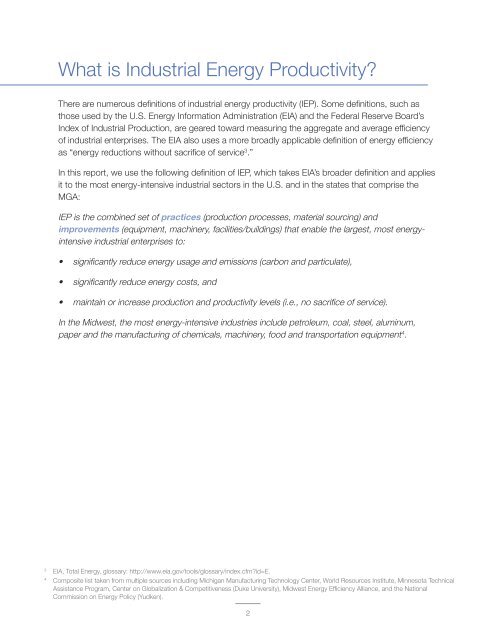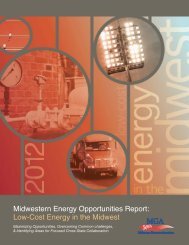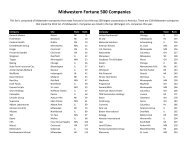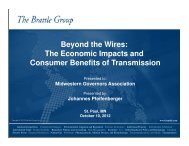Industrial Energy Productivity: Manufacturing Sector in the Midwest
Industrial Energy Productivity: Manufacturing Sector in the Midwest
Industrial Energy Productivity: Manufacturing Sector in the Midwest
Create successful ePaper yourself
Turn your PDF publications into a flip-book with our unique Google optimized e-Paper software.
What is <strong>Industrial</strong> <strong>Energy</strong> <strong>Productivity</strong><br />
There are numerous def<strong>in</strong>itions of <strong>in</strong>dustrial energy productivity (IEP). Some def<strong>in</strong>itions, such as<br />
those used by <strong>the</strong> U.S. <strong>Energy</strong> Information Adm<strong>in</strong>istration (EIA) and <strong>the</strong> Federal Reserve Board’s<br />
Index of <strong>Industrial</strong> Production, are geared toward measur<strong>in</strong>g <strong>the</strong> aggregate and average efficiency<br />
of <strong>in</strong>dustrial enterprises. The EIA also uses a more broadly applicable def<strong>in</strong>ition of energy efficiency<br />
as “energy reductions without sacrifice of service 3 .”<br />
In this report, we use <strong>the</strong> follow<strong>in</strong>g def<strong>in</strong>ition of IEP, which takes EIA’s broader def<strong>in</strong>ition and applies<br />
it to <strong>the</strong> most energy-<strong>in</strong>tensive <strong>in</strong>dustrial sectors <strong>in</strong> <strong>the</strong> U.S. and <strong>in</strong> <strong>the</strong> states that comprise <strong>the</strong><br />
MGA:<br />
IEP is <strong>the</strong> comb<strong>in</strong>ed set of practices (production processes, material sourc<strong>in</strong>g) and<br />
improvements (equipment, mach<strong>in</strong>ery, facilities/build<strong>in</strong>gs) that enable <strong>the</strong> largest, most energy<strong>in</strong>tensive<br />
<strong>in</strong>dustrial enterprises to:<br />
• significantly reduce energy usage and emissions (carbon and particulate),<br />
• significantly reduce energy costs, and<br />
• ma<strong>in</strong>ta<strong>in</strong> or <strong>in</strong>crease production and productivity levels (i.e., no sacrifice of service).<br />
In <strong>the</strong> <strong>Midwest</strong>, <strong>the</strong> most energy-<strong>in</strong>tensive <strong>in</strong>dustries <strong>in</strong>clude petroleum, coal, steel, alum<strong>in</strong>um,<br />
paper and <strong>the</strong> manufactur<strong>in</strong>g of chemicals, mach<strong>in</strong>ery, food and transportation equipment 4 .<br />
3<br />
EIA, Total <strong>Energy</strong>, glossary: http://www.eia.gov/tools/glossary/<strong>in</strong>dex.cfmid=E.<br />
4<br />
Composite list taken from multiple sources <strong>in</strong>clud<strong>in</strong>g Michigan <strong>Manufactur<strong>in</strong>g</strong> Technology Center, World Resources Institute, M<strong>in</strong>nesota Technical<br />
Assistance Program, Center on Globalization & Competitiveness (Duke University), <strong>Midwest</strong> <strong>Energy</strong> Efficiency Alliance, and <strong>the</strong> National<br />
Commission on <strong>Energy</strong> Policy (Yudken).<br />
2







